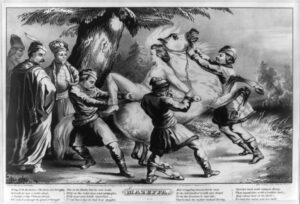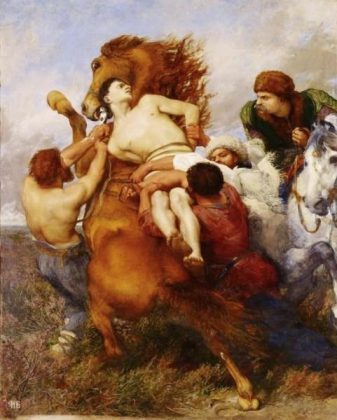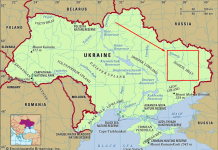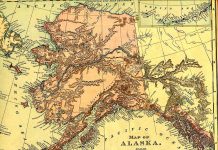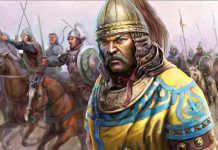Near the end of the 17th century, Ukrainian Cossacks had a Hetman whose name would be known all over Europe and later on around the world. His name was Ivan Mazepa and he had an extremely bright personality. Well-educated in Kyiv, Warsaw, and Italy, he spoke freely several languages and had an outgoing charismatic nature. He restored churches, built educational institutions, and was known on the European political scene to the extent that even French Voltaire admired him. In the beginning, Mazepa was on good terms with Peter the First to the extent that some contemporaries considered this kind of relationship as a friendship. But after Peter decided to restrict the Cossacks’ rights thus further violating previous agreements, Ivan Mazepa chose to take the side of the Swedish Army of King Charles XII against Peter’s Army in the crucial battle under the Ukrainian city of Poltava. That dramatic battle became a black day for the Swedish Army and the Swedish dominance on the continent. And Mazepa together with Charles XII had to flee Ukraine to Moldova. But the power of his personality and his and Ukraine’s drama was so strong, that more than a century later, British poet Lord Byron devoted one of his most famous poems to Mazepa. It is called “Mazeppa” and it starts with the description of the Poltava battle:
‘Twas after dread Poltuwa’s day,
When fortune left the royal Swede–
Around a slaughtered army lay,
No more to combat and to bleed.
The power and glory of the war,
Faithless as their vain votaries, men,
Had passed to the triumphant Czar,
And Moscow’s walls were safe again–
Until a day more dark and drear,
And a more memorable year,
Should give to slaughter and to shame
A mightier host and haughtier name;
A greater wreck, a deeper fall,
A shock to one–a thunderbolt to all.
Later in the poem, Lord Byron mentions an instance in Ivan Mazeppa’s young life, namely his affair with a Polish Countess Theresa during his days as a page at the Court of King John II Casimir Vasa.
Countess Theresa was married to a much older Count. On learning of the affair, the Count tied Mazepa naked to a wild horse and set the horse loose.
‘Bring forth the horse!’ The horse was brought;
In truth, he was a noble Steed,
A Tartar of the Ukraine breed,
Who looked as though the Speed of thought
Were in his limbs – but he was wild,
Wild as the wild deer, and untaught,
With spur and bridle undefiled;
‘Twas but a day he had been caught,
And snorting with erected mane
And struggling fiercely but in vain,
In the full foam of wrath and dread,
To me, the Desert-born was led. –
They bound me on, that menial throng,
Upon his back with many a thong,
Then loosed him with a sudden lash
Away! – Away! – and on we dash! –
Torrents less rapid and less rash.
The poem almost immediately became a theater performance and at once became an unbelievable success – after its first season in 1831, the play ran for several hundred performances at Astley’s Royal Amphitheatre in London.
It was revived numerous times many years subsequently in both England and later in America.
But the most famous production was the one that starred the celebrated Adah Isaacs Menken, an American actress, who played the role of Mazeppa for American audiences in 1861 and for English audiences two years later to great acclaim.
In fact, Adah Isaacs Menken became the highest-earning actress of her time mostly because of her performance in this melodrama, where she played a young Ukrainian hetman with a climax that featured her apparently nude and riding a horse on stage.
Lord Byron was not the only one inspired by the life of Ivan Mazepa by the way – Piotr Chaikovsky composed the opera “Mazeppa”, Franz List – symphonic opera with the same name, Victor Hugo wrote a poem, Voltaire devoted a lot of attention to the personality of Ivan Mazepa in his “History of Charles XII of Sweden.”
Voltaire’s account of quarell between Mazeppa and Peter I >
Emboldened by his Poltava success, Peter I moved his forces via Moldova toward Turkey. Read how the Pruth Campaign ended for Peter and his army >
